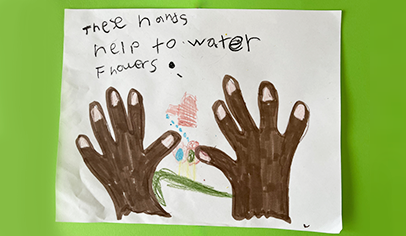Helping Hands

Learning area: Social-Emotional, Art, Language Arts
Time commitment: One 45-minute session or two 30-minute sessions
Best for: Prekindergarten, Kindergarten, Grade 1, Grade 2

Build children’s awareness of the many ways they can help others in school, home, and community. Children can contribute to a diverse, collaborative community by building social and self-awareness, being accepting, and supporting the community through responsible decisions. Self-awareness and responsible decision-making develop when students identify and display helping habits.
Materials:
- Crayola Colors of the World ™Crayons
- Crayola Colors of the World™ Markers
- Drawing Paper
- Bulletin Board or Roll of Paper
- Tape or Glue
- Sticky Notes
Instructions:
CREATE. Children will:
- Discuss ways their hands help others at school, home, and in the community. Examples are playing with a baby, planting and tending a garden, writing supportive notes to someone, clapping and singing a “pick me up” song, picking up others’ toys to foster collaboration, drawing a “community-spirit” mural, and so on.
- Identify which of the Colors of the World crayons or markers match the skin tones they would like to use in their art, using language that celebrates diversity and honors the varied colors that make up the community. Help one another trace hands and then add color and details to their art. On a separate piece of paper, use the crayons to draw one way their hands help, and write a one-sentence description beginning with “These hands…”
PRESENT. Ask children to:
- Share their art and writing with other classmates, noting the similarities in how they help others at school, home, and in the community.
RESPOND. Children will:
- Sort into sets and subsets the common themes seen in their art. Use the illustrations to prompt a discussion about responsible decision-making.
- Work together to organize the art on a bulletin board or large paper mural that depicts the patterns they saw. They might cluster the most frequently illustrated types of help and provide a place of honor for the examples that appear less frequently and celebrate uniqueness.
CONNECT. Children will:
- Display the art in a place where others can view it and leave positive feedback on sticky notes. There can be a heading over the display with questions such as: What surprises you about how we help others? How could we help you? Photograph the display and feedback to share on the school’s website or newsletter.
- Make a plan to expand the way students’ helping hands will contribute in the next few weeks. The ways people help each other can always be extended.
Learn More:
- If this activity is done remotely, give families tips for how to display the artwork at home.
- There are many frameworks for social-emotional learning. CASEL Social Emotional Competencies are at https://casel.org/sel-framework/
- Doug Fisher, John Hattie, and Nancy Frey: The Distance Learning Playbook, Grades K-12: Teaching for Engagement and Impact in Any Setting, June 2020
- Crayola offers lessons, projects, webinars, and other support at https://www.crayola.com/education
- Learn more about the benefits of art integration at PrincipalCrayola_SeptOct17_smallsp.pdf



